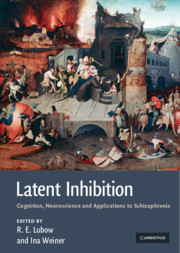Book contents
- Frontmatter
- Contents
- List of contributors
- Preface
- 1 A short history of latent inhibition research
- Current topics in latent inhibition research
- 2 Latent inhibition and extinction: their signature phenomena and the role of prediction error
- 3 Inter-stage context and time as determinants of latent inhibition
- 4 Latent inhibition: acquisition or performance deficit?
- 5 Latent inhibition and learned irrelevance in human contingency learning
- 6 Associative and nonassociative processes in latent inhibition: an elaboration of the Pearce–Hall model
- 7 From latent inhibition to retrospective revaluation: an attentional-associative model
- 8 Latent inhibition and habituation: evaluation of an associative analysis
- 9 Latent inhibition and creativity
- 10 The phylogenetic distribution of latent inhibition
- 11 The genetics of latent inhibition: studies of inbred and mutant mice
- 12 A comparison of mechanisms underlying the CS–US association and the CS–nothing association
- 13 The pharmacology of latent inhibition and its relevance to schizophrenia
- 14 Parahippocampal region–dopaminergic neuron relationships in latent inhibition
- 15 Latent inhibition and other salience modulation effects: same neural substrates?
- 16 What the brain teaches us about latent inhibition (LI): the neural substrates of the expression and prevention of LI
- 17 Latent inhibition in schizophrenia and schizotypy: a review of the empirical literature
- 18 A cautionary note about latent inhibition in schizophrenia: are we ignoring relevant information?
- 19 Latent inhibition as a function of anxiety and stress: implications for schizophrenia
- 20 Nicotinic modulation of attentional deficits in schizophrenia
- 21 Latent inhibition and schizophrenia: the ins and outs of context
- Summary and conclusions
- Index
- References
16 - What the brain teaches us about latent inhibition (LI): the neural substrates of the expression and prevention of LI
from Current topics in latent inhibition research
Published online by Cambridge University Press: 04 August 2010
- Frontmatter
- Contents
- List of contributors
- Preface
- 1 A short history of latent inhibition research
- Current topics in latent inhibition research
- 2 Latent inhibition and extinction: their signature phenomena and the role of prediction error
- 3 Inter-stage context and time as determinants of latent inhibition
- 4 Latent inhibition: acquisition or performance deficit?
- 5 Latent inhibition and learned irrelevance in human contingency learning
- 6 Associative and nonassociative processes in latent inhibition: an elaboration of the Pearce–Hall model
- 7 From latent inhibition to retrospective revaluation: an attentional-associative model
- 8 Latent inhibition and habituation: evaluation of an associative analysis
- 9 Latent inhibition and creativity
- 10 The phylogenetic distribution of latent inhibition
- 11 The genetics of latent inhibition: studies of inbred and mutant mice
- 12 A comparison of mechanisms underlying the CS–US association and the CS–nothing association
- 13 The pharmacology of latent inhibition and its relevance to schizophrenia
- 14 Parahippocampal region–dopaminergic neuron relationships in latent inhibition
- 15 Latent inhibition and other salience modulation effects: same neural substrates?
- 16 What the brain teaches us about latent inhibition (LI): the neural substrates of the expression and prevention of LI
- 17 Latent inhibition in schizophrenia and schizotypy: a review of the empirical literature
- 18 A cautionary note about latent inhibition in schizophrenia: are we ignoring relevant information?
- 19 Latent inhibition as a function of anxiety and stress: implications for schizophrenia
- 20 Nicotinic modulation of attentional deficits in schizophrenia
- 21 Latent inhibition and schizophrenia: the ins and outs of context
- Summary and conclusions
- Index
- References
Summary
Scores of experiments in the field of animal learning have demonstrated that conditioning to a stimulus depends not merely on its current relationship with a reinforcer, but is affected by animal's past experience with that stimulus. Latent inhibition (LI) is one case of such a biasing effect of past experience: it reflects the proactive interference of nonreinforced stimulus preexposure on the subsequent performance of a learning task involving this stimulus (Lubow,1973, 1989; Lubow, Weiner, & Schnur, 1981).
LI can be demonstrated in a variety of classical and instrumental conditioning procedures, and in many mammalian species, including humans (Lubow, 1973, 1989; Lubow et al., 1981). While a variety of behavioral tasks are used to demonstrate LI in rodents, all of them share a basic procedure. In the first stage, preexposure, animals from each of two groups are placed in an environment that will later serve as the conditioning–test apparatus. Subjects in the “stimulus preexposed” (PE) group are repeatedly exposed to a stimulus (e.g., tone) which is not followed by a significant consequence. Subjects in the “nonpreexposed” (NPE) group spend an equivalent amount of time in the apparatus without receiving the stimulus. When the preexposure stage is completed, either immediately, or a certain time later, all of the subjects enter the conditioning stage, in which the preexposed stimulus is paired with a reinforcer over a number of trials. Performance is assessed by examining some behavioral index of conditioned responding, either during the conditioning stage or in a third, test stage.
- Type
- Chapter
- Information
- Latent InhibitionCognition, Neuroscience and Applications to Schizophrenia, pp. 372 - 416Publisher: Cambridge University PressPrint publication year: 2010
References
- 5
- Cited by



